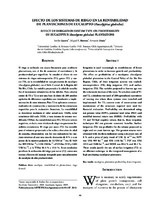Efecto de los sistemas de riego en la rentabilidad de plantaciones de eucalipto (Eucalyptus globulus)
Effect of irrigation system type on profitability of eucalyptus (Eucalyptus globulus) plantations
Autor
Guerra Bugueño, Emilio Ricardo
Herrera Machuca, Miguel Ángel
Drake Aranda, Fernando
Editor
Colegio de Postgraduados (México)Fecha
2010Materia
EucaliptoRentabilidad de plantaciones
Riego forestal
Eucalyptus
Plantation profitability
Forest irrigation
METS:
Mostrar el registro METSPREMIS:
Mostrar el registro PREMISMetadatos
Mostrar el registro completo del ítemResumen
El riego es utilizado con mayor frecuencia para establecer
plantaciones, con el fin de aumentar el crecimiento y la
productividad por superficie. Se estudió el efecto de tres
sistemas de riego: microaspersión (T1), goteo (T2) y surco
(T3), en la rentabilidad de una plantación de eucalipto
(Eucalyptus globulus), en el Valle Central de la Región del
Bío Bío, Chile. La variable proyectada a la edad de cosecha
fue el incremento volumétrico de los árboles. Para calcular
costos de T1 y T2 se usó una base de datos de 200 predios
agrícolas de diferentes superficies con instalación e implementación
de estos sistemas. Para T3 se aplicaron costos actualizados
de construcción y mantención de las estructuras
requeridas para la evaluación financiera. La rentabilidad
se determinó mediante el valor actual neto (VAN), valor
económico del suelo (VES), y tasa interna de retorno modificada
(TIRm). La rentabilidad para T1 y T2 tuvo valores
negativos, es decir, estas técnicas de riego no generaron beneficios
económicos. El riego por surco (T3) fue rentable
para el volumen proyectado a los ocho y diez años de edad
de cosecha, obteniéndose con los tres indicadores los mayores
retornos al usar una tasa de descuento de 8 % y a un
precio de la madera pulpable de 32 US$ m3 ssc. El VAN
fue 989 US$ ha1 y 1106 US$ ha1, el VES fue 2152 y 2406
US$ ha1, y la TIRm 10.4 % y 10.1 %. Estos resultados
justifican la utilización del riego por surco (T3) como una
técnica eficiente del manejo integrado para una plantación
de eucalipto de alta productividad. Irrigation is used increasingly in establishment of forest
plantations in order to increase growth and productivity.
The effect on profitability of a eucalyptus (Eucalyptus
globulus) plantation in the Central Valley of the Bío Bío
Region, Chile, of three irrigation systems was studied:
microsprinklers (T1), drip irrigation (T2) and surface
irrigation (T3). The variable projected to harvest age was
the volumetric increase of the trees. To calculate costs of T1
and T2, a database was used of 200 agricultural operations
of varying size where these systems were installed and
implemented. For T3, current costs of construction and
maintenance of the structures required were used for
financial evaluation. Profitability was determined using
net present value (NPV), potential land value (PLV) and
modified internal return rate (MIRR). Profitability with
T1 and T2 had negative values; that is, these irrigation
techniques did not generate economic benefits. Surface
irrigation (T3) was profitable for the volume projected to
eight and ten years harvest age. The greatest returns were
obtained with the three indicators using a discount rate of
8 % and a price of pulp wood of US$ 32 m3 ssc. NPV
was US$ 989 ha1 and US$ 1106 ha1; PLV was US$
2152 and 2406 ha1, and MIRR was 10.4 % and 10.1 %.
These results justify the use of surface irrigation (T3) as
an efficient technique in the integrated management of a
high-producing eucalyptus plantation.

